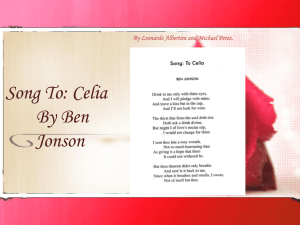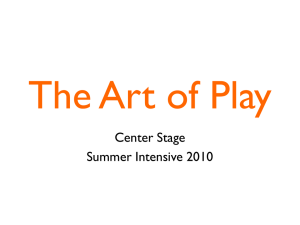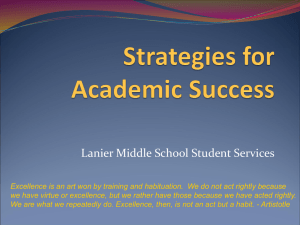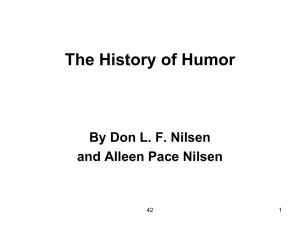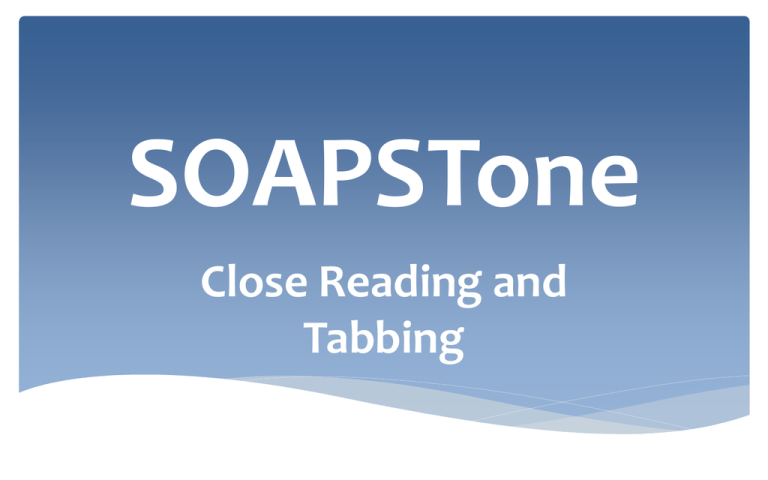
SOAPSTone
Close Reading and
Tabbing
Close Reading
Reading slowly and carefully
Reading with a pen, a notebook, tabs, high lighters
Keeping track of questions you may have
Reading the text as a whole vs. looking for specific
elements of the text
Analyzing your own thoughts, writing, questions about
the text in order to construct patterns, devise themes,
and establish SOAPSTone.
ANNOTATE! Passive Vs Active
Passive readers look at a book with the TV. on, controller in one
hand, cellphone in the other while checking Instagram, Tweeting,
and taking a nap
Active readers underline key passages, circle words or concepts they
do not understand, and make connections with literature they have
read as well as their own realities
Look for Patterns
Observe the interior of the passage. Find patterns and statements
or objects that repeat
Write down the names of characters and draw arrows to illustrate
how those characters are related and how they move through the
text.
Use the margins and inside covers for your maps and drawings
Analyze your thoughts and drawings-look for more information in
the reading to add depth to what you understand and resolve that
which you don’t understand
For Example…
What metaphor does Busta Rhymes repeat?
Animal Metaphors!
A Pattern of metaphors is called a CONCEIT!
You just became a literary genius!
Acronym
S)Speaker
O)Occasion
A) Audience
P) Purpose
S) Subject
T)one
Speaker
The speaker is the voice that tells
the story. Although the Speaker is
telling the story, he may NOT be the
protagonist
Tyler
Durden
From
Fight
Club
Frank From Donnie Darko
To Consider…
Is the voice of the text a fictional character?
How does the speaker tell the story?
What type of language does the speaker use?
How does the speaker influence the reader to
think a certain away about the events in
the text?
FINALLY!!!
Does the subject or the voice describing the
subject change---or shift at all during the
story?
Those shifts are VERY important! They are
often overlooked textual elements that speak
to a characters growth and development.
Occasion
The occasion relates to the time and place in which the text is set.
The reader NEEDS to understand the text in context-meaning the
situation that led the writer to write his text. Understand that this
component HAS to be present. Literature does not exist in a
vacuum, it is a product of a writer living in a very certain and very
important environment.
Kurt Vonnegut’s “Harrison Bergeron”
THE YEAR WAS 2081, and everybody was finally equal. They
weren't only equal before God and the law. They were equal
every which way. Nobody was smarter than anybody else.
Nobody was better looking than anybody else. Nobody was
stronger or quicker than anybody else. All this equality was
due to the 211th, 212th, and 213th Amendments to the
Constitution, and to the unceasing vigilance of agents of the
United States Handicapper General.
Some things about living still weren't quite right, though.
April for instance, still drove people crazy by not being
springtime. And it was in that clammy month that the H-G
men took George and Hazel Bergeron's fourteen-year-old
son, Harrison, away.
What elements contribute to making the occasion?
Modernity and Zeitgeist
Keep in mind…
The way in which you perceive a text is almost COMPLETELY dependent upon
your cultural zeitgeist.
AND
The way in which past and future audiences perceive meaning in a text is
dependent on their cultural zeitgeist
JUST LIKE
The zeitgesit for the author almost COMPLETELY structured and informed his
work
What does that mean for us, the readers???
When we find some element of a text significant it is because some aspect of our
cultural zeitgeist motivates us to think so!
Audience
Based on the language, subject matter, and content-what is the
target group of readers? Who is the author attending to address?
Understanding audience is key to gaining insight as to the author’s
purpose in writing a text. You must understand that for a text to
create real change then it must get into the hands of those who can
truly make that change.
You should also note who the text is not intended for…
Blackalicious-Alphabet Aerobics
Who is the intended audience?
What techniques are used to pique the interests of the targeted audience?
Who isn’t the intended audience?
How can you tell?
What does the artist have to gain by making this particular song for his
audience?
Watagatapitusberry
Who is the intended audience?
What techniques are used to ‘arouse’ the interests of the targeted
audience?
Who isn’t the intended audience?
How can you tell?
What does the artist have to gain by making this particular song for his
audience?
Do not Underestimate the
Significance of Comedy!!!
An author’s use of comedic elements can
enhance your understanding of who he is
targeting as his intended audience…
Many people think or assume comedy is an emotional process-it is not!
Comedy is an intellectual process that draws from deeply-rooted
psychological traits… Comedy is UNIVERSAL!
Why do we laugh?
What do comedy and tragedy have in common?
How do we discuss comedy?
Understanding WHY we laugh (or don’t) tells
us a lot about us as an audience!
Understanding WHY other audiences laugh (or
don’t) tells us a lot about them!
There are several “levels”
of comedy-we call this The
Comedic Ladder
1. Low Comedy
Low Comedy is full of
-Dirty jokes, gestures, scatological humor (Netflix Clip), and sexual overtones
-Low comedy focuses on exaggerating or understating physical features. (Example
from President’s Correspondence Dinner:
Jimmy Kimmel: Mr. President, you may want to cover your ears for this next joke-if
that is humanly possible.”
-Slapstick, prop comedy, collisions and physical comedy
2. Farce
A Farce, or something that can be considered farcical:
-Is full of coincidences, mistimings, and mistaken identity
-Contains characters are “puppets of fate”-twins, born to the
wrong class, unable to marry, too poor or too rich
-May feature characters that have lost there identity due to some
accident of fate
3. Comedy of Manners
A Comedy of Manners focuses on witty, clever speechtypically among the upper class or rich. Insults, put-downs
are traded between cliques and groups.
In particular, outsiders are viewed as witless and are
deemed made to feel ashamed or embarrassed that they
do not possess the attributes of the “In-Class”
4. Comedy of Ideas
Characters engaged in a Comedy of Ideas typically
argue about politics, Religion, sex, marriage and culture
(art/music/literature).
They use witty, clever language to mock or demean
their opponents.
Soooo
BE ON THE LOOKOUT FOR
ANY CUES THAT HINT AT
THE AUTHOR’S INTENDED
AUDIENCE! ?
Why
Understanding Audience
Understanding the audience is one key in figuring out the author’s
intended message. For example, knowing that Douglass was writing
to Abolitionists about the philosophical and humanitarian crimes
associated with slavery; Faulkner was writing to showcase the
relationship with between actual human thought and literature;
Shakespeare was writing in order to ask questions about existence
that had never been asked before; Kurt Vonnegut wrote to illustrate
the goodness of humanity; O’Brien wrote to tell us a “true war
story”; Spiegelman wrote to explicate his personal and familial
understanding of the Holocaust…
Knowing an audience allows to
access these emerging themes in
literature-without an audience these
great truths would vanish in the
wind
It’s Tricky! (Tricky Tricky Tricky)
Keep in mind that an author might use Low Comedy in
order to illustrate a philosophical, academic, or intellectual
point
Or, vice versa…
An author might depict characters normally associated
with farce or low comedy engaged in a Comedy of Ideas.
Purpose
After you consider the occasion, audience, and speaker
you can start to make assertions about what the author
intended his work to do.
What logic, thesis, and/or arguments are buried within the
text?
What would the author want you to do the second after
you finish reading his book?
To establish purpose, an
author uses a blend of
rhetorical techniques that
rely on 3 elements of rhetoric
Elements of Rhetoric: Ethos
The intent to build up the credibility
of the speaker so that you trust him
more. Ethos heavily relies on
REPUTATION and on attacking
the reputations of rivals.
Elements of Rhetoric: Pathos
The passionate and emotional
elements of an argument. This
type of argument is supposed to
inspire you to feel for and identify
with the speaker.
Elements of Rhetoric: Logos
The logical aspect of an
argument meant to appeal
to your sense of reason.
Arguments From Al Pacino’s Devil’s
Advocate Speech
Ethos
Logos
Pathos
Subject
The general topic, content, and ideas contained in
the text.
How do you know this?
How has the subject been depicted?
Why would the author choose to present this topic?
In what style or format has the subject been presented?
Why/how does the presentation of the text craft and form the
subject?
This Is Just To Say
I have eaten
the plums
that were in
the icebox
and which
you were probably
Saving
for breakfast
Forgive me
they were delicious
so sweet
and so cold
by William Carlos Williams
From Chapter 1 of Sören Kierkegaard’s
The Sickness unto Death
Chapter 1: That Despair is the Sickness Unto Death
A.
Despair is a Sickness in the Spirit, in the Self, and So It May Assume a Triple Form: in Despair at Not Being Conscious of Having
a Self (Despair Improperly So Called); in Despair at Not Willing to Be Oneself; in Despair at Willing to Be Oneself.
Man is spirit. But what is spirit? Spirit is the self. But what is the self ? The self is a relation which relates itself to its
own self, or it is that in the relation [which accounts for it] that the relation relates itself to its own self; the self is not
the relation but [consists in the fact] that the relation relates itself to its own self. Man is a synthesis of the infinite
and the finite, of the temporal and the eternal, of freedom and necessity, in short it is a synthesis. A synthesis is a
relation between two factors. So regarded, man is not yet a self.
In the relation between two, the relation is the third term as a negative unity, and the two relate themselves to the
relation, and in the relation to the relation; such a relation is that between soul and body, when man is regarded as
soul. If on the contrary the relation relates itself to its own self, the relation is then the positive third term, and this is
the self.
Such a relation which relates itself to its own self (that is to say, a self) must either have constituted itself or have
been constituted by another.
If this relation which relates itself to its own self is constituted by another, the relation doubtless is the third term,
but this relation (the third term) is in turn a relation relating itself to that which constituted the whole relation.
Got All That?
The subject of literature can be extremely easy to spot, understand,
and discuss…
The subject of literature can be incredibly difficult (impossible?) to
spot, understand and discuss…
The key is to understand that the author has intentionally buried his
subject or intentionally placed his subject front and center-both
strategies pertaining to subject are important elements in
discussing literature
Tone
Tone refers to the attitude of the
author as expressed in his text. To
track tone one must track the
specific word choice used by the
narrator or speaker within a text.
We examine the types of words (diction), word
arrangements, and techniques involving the
manipulation of the sound and meaning of
words because…THESE TECHNIQUES ARE ALL
INTENTIONAL AND ALL SERVE A PURPOSE IN
THE TEXT!
Does the author use….
Alliteration?
Repetition of sounds at the beginning of a
string of words (as in a tongue twister)
Macbeth (Act 4, scene 1)
“Double, double toil and trouble;
Fire burn, and caldron bubble.”
What is the effect of the alliteration in
Macbeth?
Allusion
Reference to a previous text-typically biblical… But an
allusion can simply be a reference to any previously
existing text, song, speech, or document…
In this case, the song from Harry Potter is a lengthy
allusion to Shakespeare’s Macbeth.
Cacophony?
Combinations of sounds and words that contain harsh
consonant sounds (K, P, Q, P) and an absence of
“soothing” vowel and consonant sounds (O, S, L, M).
Also used in music…
Throw a bag of plates, silverware, and glass cups down
some stairs and VOILA! You will have cacophony.
What is the effect of the Cacophony
in…
Dillinger Escape Plan
“43% Burnt”
Onomatopoeia?
When something or some action is named for or after the sound it
makes…
Buzz
Hiss
Belch
Bang Clang
Pop
“Plop, plop, fizz, fizz, oh what a relief it is." (slogan of Alka Seltzer, U.S.)
?
What is the Intended Effect of
Onomatopoeia?
Under what Circumstance should
a writer use Onomatopoeia?
Comedic Effect
ZZZZZZZZZ
What
about
here?
I heard a Fly buzz - when I died
I heard a Fly buzz - when I died The Stillness in the Room
Was like the Stillness in the Air Between the Heaves of Storm The Eyes around - had wrung them dry And Breaths were gathering firm
For that last Onset - when the King
Be witnessed - in the Room I willed my Keepsakes - Signed away
What portion of me be
Assignable - and then it was
There interposed a Fly With Blue - uncertain - stumbling Buzz Between the light - and me And then the Windows failed - and then
I could not see to see - BY EMILY DICKINSON
Also, Look at syntax
(sentence structure). Does
the author use…
Short Sentences? (Note the Dialogue from
the Second Speaker Who is a Man)
The girl stood up and walked to the end of the station. Across, on the other side,
were fields of grain and trees along the banks of the Ebro. Far away, beyond the
river, were mountains. The shadow of a cloud moved across the field of grain
and she saw the river through the trees.
‘And we could have all this,’ she said. ‘And we could have everything and every day
we make it more impossible.’
‘What did you say?’
‘I said we could have everything. We can have everything.’
‘No, we can’t.’
‘We can have the whole world.’
‘No, we can’t.’
From Ernest Hemmingway’s
‘We can go everywhere.’
Hills Like White Elephants
‘No, we can’t. It isn’t ours any more.’
Long sentences? (From Absolom,
Absalom! By William Faulkner)
“There was a wisteria vine blooming for the second time that summer on a
wooden trellis before one window, into which sparrows came now and
then in random gusts, making a dry vivid dusty sound before going away:
and opposite Quentin, Miss Coldfield in the eternal black which she had
worn for forty-three years now, whether for sister, father, or nothusband
noone knew, sitting so bolt upright in the straight hard chair that was so
tall for her that her legs hung straight and rigid as if she had iron
shinbones and ankles, clear of the floor with that air of impotent and
static rage like children’s feet, and talking in that grim haggard amazed
voice until at last listening would renege and hearing-sense self-confound
and the long-dead object of her impotent yet indomitable frustration
would appear, as though by outraged recapitulation evoked, quiet
inattentive and harmless, out of the binding and dreamy and victorious
dust.”
Stream of consciousness?
A writing style intended to
replicate the pattern of human
thought-often characterized by
leaps in logic, a lack of
punctuation, and vivid imagery
From Dalton Trumbo’s Johnny Got His
Gun
He went down into the water again and fought and fought and then came
up with his belly jumping and his throat aching. And all the time that he
was under the water fighting with only one arm to get back he was
having conversation with himself about how this thing couldn't possibly
happen to him only it had. So they cut my arm off. How am I going to
work now? They don't think of that. They don't think of anything but
doing it their own way. Just another guy with a hole in his arm let's cut it
off what do you say boys? Sure cut the guy's arm off. It takes a lot of
work and a lot of money to fix up a guy's arm. This is a war and war is
hell and what the hell and so to hell with it. Come on boys watch this.
Pretty slick hey? He's down in bed and can't say anything and it's his
tough luck and we're tired and this is a stinking war anyhow so let's cut
the damn thing off and be done with it.
Keep track of figurative language. Are similes and
metaphors employed? Does the other take
advantage of imagery? If so, how would you describe
the images used? Ghastly? Pastoral? Soothing?

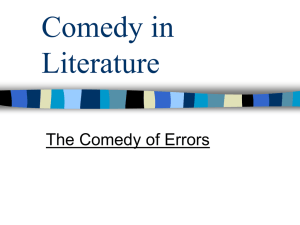
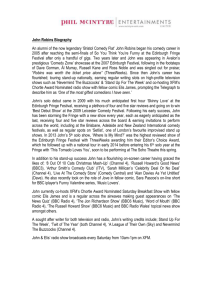
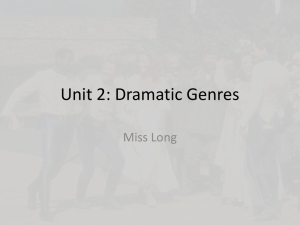
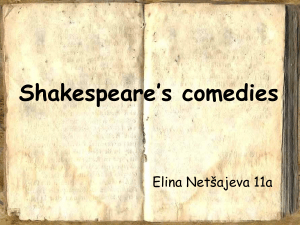
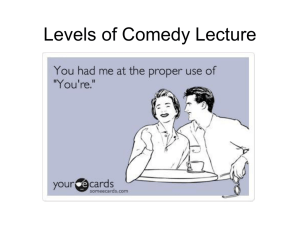
![[Lecture 19] studio system 2 for wiki](http://s2.studylib.net/store/data/005217793_1-c296c1b3b7b87d52a223478e417a702f-300x300.png)
